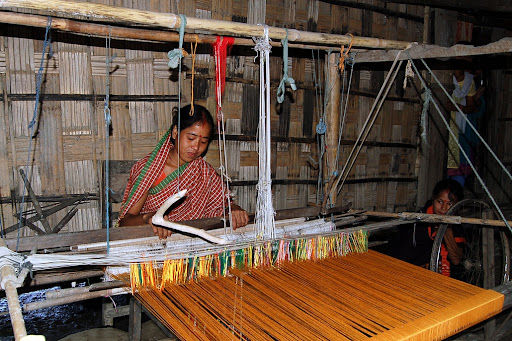
Majuli Island in Assam has the reputation as the largest riverine island in the world. Home to the Satras, 600 year old religious institutions of Shankarite Neo-Vaishnavism, a way of life began and preached by Hindu saint Shri Sankardeva, you are greeted with a lush greenery, serenity and peace, as you step inside the island, away from the incessant crowds of the mainland cities. The very few inhabitants of the island have adopted a peaceful and simple way of life, which makes your trip to this enchanting island even more memorable.
Getting to the Island
There are various ways to reach Majuli. It is your choice. You can either choose the North bank or the South bank (of Brahmaputra) routes. Brahmaputra river slices Assam plains into two and Majuli is located in the middle of this river in upper Assam.
One can catch buses or trains to Jorhat town from Guwahati (ISBT for bus, Kamakhya or Guwahati station for train) if one wishes to go in the south bank route. From Jorhat, one can avail cars and other public vehicles towards Nimati ghat (less than an hour from Jorhat town) and cross the river Brahmaputra by ferry and reach places like Garamur and Kamalabari in lower Majuli areas. (less than an hour on ferry to reach the island).
Within the island, bicycles and scootys are available for rent and can cost anywhere between ₹100 to ₹500. These are infact the best ways to travel around the island at your own pace.
Geography of the Island
The Island which was once around 1500 sq. km, has now lost one third of its area owing to slow erosion by the waters of Brahmaputra river. It currently spans over 500 sq. km. The mighty Brahmaputra flows to the south of the island while an anabranch of the river, Kherkutia Xuti joins the River Subansiri in the north. Home to several indigenous tribes of Assam, like the Mishings, Deori and Sonowal tribes, the island boasts of a proud biodiversity as well. On landing on the Island, you will notice the beautiful white flats of sands which almost resembles a beach, but as you push deeper into the heart of the Island, you will be mesmerized by the endless greenery and fields, water bodies. The outer areas of Garmur and Kamalabari is fairly populated and resembles any normal Assamese town, as you push deeper inside you will notice the simple and austere rural life of the Island.
Best time to visit Majuli
I suggest the period between September to early March for your trip to the Island, as you can avoid the monsoon of Assam as well as the blistering heat of summers, in this time, making your visit more pleasant.
Things to experience in Majuli
The Satras - The satras are the temples/monasteries for people following the Assamese (Sankarite) Neo-Vaishnavism. It is here that the ideology, worship to the sect is imparted. Naaghars are the main places of worship within the satras. There are 31 Satras within Majuli, although the most important ones are Dakshinapat Satra, Kamalabari Satra, Auniati Satra, Garamur, Bengena-ati and Samaguri Satra. Catch the morning or evening prayers, to experience the beauty and culture of the place. You will fall in love with the rythamic hymns, prayers and the sweet sounds of cymbals being played which imparts a sense of serenity and peace.

Salmora Village, the heaven of Pottery - Located in the southeast corner of the Island, and close to the Dakshinapat Satra, this village is home to some of the most skilled potters (Kumar potters), who uses their bare hands rather than pottery wheels for their magnificent creations. Politely approach one of the settlements, and the kind community will be more than happy to show ypu around. Interestingly, most of the craft is credited to the skilled female artisans of the community who makes almost 21 varietes of earthenware pots.

Samaguri Satra's famous Mask making Village - The Samaguri Satra is creditted with keeping the mask making culture of the sect alive. Masks used to be an integral part in the religious performances called Bhaona, of the sect. These masks are used to depict various characters, including deities, demons, ancestral beings pertaining to Hindu Faith. These masks are made primarily with bamboo, although clay and wood are sometimes used. The settlement around Samaguri Satra is a must visit, and do purchase some of the mask as they make beautiful souvenirs as well as contribute to keeping the art and its practitioners alive.

Majuli Handlooms - Majuli islands also boasts of a lovely co-operative industry of indigenous handloom products including saris, traditional Assamese Gamusa and the famed Assamese Mekhela Chador. The simple village folks weave some of the most beautiful and attractive fabrics you will ever see. Do visit their outlets and purchase them, which encourages their production.

Birdwatchers paradise - Majuli is being an island, and indented with numerous beels(Ponds) and khaals(Water holes) are a perfect destination and habitat for birds like egrets and kingfishers. Winter season witnesses a beautiful influx of migratory birds. This makes Majuli a paradise for birdwatchers and avian enthusiasts. Grab your camera, and binoculars and settle yourself at a peaceful, safe distance to witness the beautiful birds.

Places to stay in Majuli
Although places for overnight stay is quite scarce in the Island, and can be found mostly in the areas of Garmur, there are several homestays which have recently come up in response to the increased tourism to the Island. These places are constructed in a local manner, with bamboo giving a more ethnic and rural experience. Other than this, the satras too have few places to accomodate devotees, for which you need to enquire and speak with the monks.
Visit before it is too late
It is believed that the Island will erode and completely vanish in next 20 years due to the erosion by Brahmaputra river. It posses a threat to the inhabitants, the culture and practice, as well a the tribes very existence. Sad and Disheartning as much as it sounds, you must visit this wonderful place and experience their rich culture and heritage, before it is too late.

